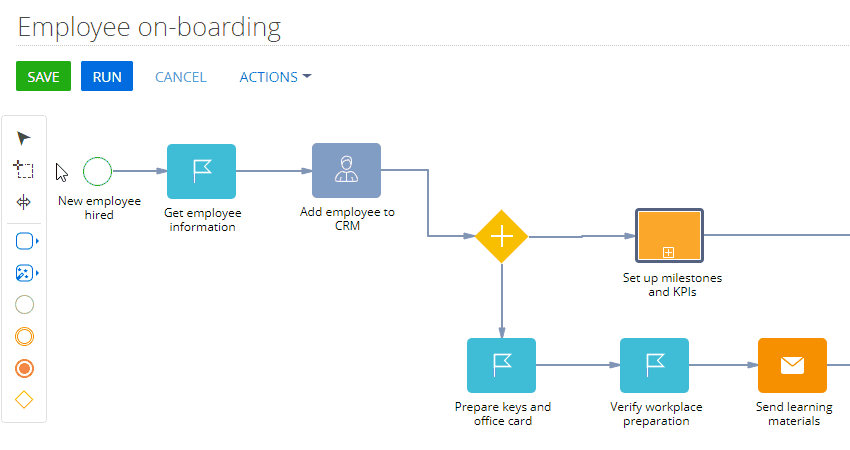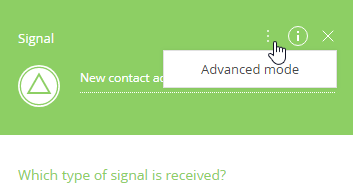Getting started with Process Designer
The Process Designer workspace is designed for creating and editing business processes. The workspace (Fig. 1) contains all elements required to create a process.

Contents
•Process element context menu (5)
•Process map and diagram zoom (6)
[Save] – saves the business process.
Note
The business-processes are automatically saved in Creatio. If a process diagram was closed without saving, it is possible to recover unsaved data.
[Run] – runs the currently open business process.
[Cancel] – discards unsaved changes.
The [Actions] menu of the Process Designer contains the following commands:
-
[Source code] – opens the source code of the business process.
-
[View Metadata] – opens the metadata of the business process.
-
[Copy diagram] – creates a copy of the business process in the [Process library] section.
-
[Export Metadata] – downloads the metadata of the current process as an .md file.
-
[Process Log] – opens the [Process log] section in a new browser tab.
-
[Save current version] – saves the current version of the business process. For example, if you have several versions of a business process, this command will save the one with which you are working.
-
[Set as actual version] – sets the current version of the business process as actual. Whenever you run a business process, you always run the “actual version” version of this process.
-
[Process parameters] – opens the list of process parameters.
-
[Import from *.bpmn] – select a local .BPMN file to import. As a result, the imported diagram will replace any current diagram. More information is available in the “Importing *.BPMN files” article.
 – opens the process settings in the element setup area.
– opens the process settings in the element setup area.
 – opens this help on the Academy.
– opens this help on the Academy.
 – searches the current diagram for process elements by name.
– searches the current diagram for process elements by name.
Searching for elements in the Process Designer
The search function in the Process Designer simplifies navigation and switching between the diagram elements during the business process setup and configuration. The search is done by the element name or code.
To open the search field (Fig. 2), click the  button or press Ctrl+F on your keyboard.
button or press Ctrl+F on your keyboard.
Fig. 2 Search field in the Process Designer

Enter the searched text in the search string and press Enter. The number of found process elements will be displayed on the right side of the field (Fig. 3).
Fig. 3 Searching for process elements and displaying search results

Use the  buttons to toggle between the found elements on the diagram. You can go to the next element by pressing the Enter or F3 keyboard keys. To go back to the previously found element, press Shift+F3 on your keyboard (Fig. 4).
buttons to toggle between the found elements on the diagram. You can go to the next element by pressing the Enter or F3 keyboard keys. To go back to the previously found element, press Shift+F3 on your keyboard (Fig. 4).
Fig. 4 Toggling between the found process elements

All found process elements are highlighted with a frame. Additionally, the currently selected element will be highlighted in orange (Fig. 5).
Fig. 5 Found elements highlighted on the process diagram

The setup area will open for the currently selected element.
Press Esc to hide the search field.
The Process Designer working area is where you design the process diagram. You can add process elements on the working area in two ways:
1.Drag an element from the element area
2.Drag an element from any element on the diagram. This will add the corresponding new element, connected to the previously selected element with a sequence flow.
Note
More information about adding process elements is available in the “Adding an element to a process” article.
The process element toolbar contains base process designer tools and a list of basic process elements that you can use to create business processes. Drag process elements from the toolbar to the working area to add them to your business process.
Use the  “Arrow” tool for typical select and move separate elements on the diagram.
“Arrow” tool for typical select and move separate elements on the diagram.
Use the  “Lasso” tool to select multiple elements via a “drag box” (Fig. 6).
“Lasso” tool to select multiple elements via a “drag box” (Fig. 6).

Use the  “Space” tool to shift all elements on the diagram left/right or up/down (Fig. 7). This tool applies to all elements to the right or left from the cursor – when shifting elements horizontally. Likewise, when shifting elements vertically, the tool will apply to all elements above the cursor (when shifting upwards) and all elements below the cursor (when shifting the elements downward).
“Space” tool to shift all elements on the diagram left/right or up/down (Fig. 7). This tool applies to all elements to the right or left from the cursor – when shifting elements horizontally. Likewise, when shifting elements vertically, the tool will apply to all elements above the cursor (when shifting upwards) and all elements below the cursor (when shifting the elements downward).

Basic process elements available on the process element area:
|
| [Perform task]. Add user actions. |
|
| [Read data]. Add system actions and sub-processes. |
|
| [Simple]. Add start events. |
|
| |
|
| [Terminate]. Add the [terminate] event. |
|
|
Use the element setup area (4) to specify parameter values for processes and process elements. The list of available parameters depends on the type of the currently selected element.
The base mode
In the base mode, the element setup area contains the main element parameters and the fields for connecting them with other Creatio records. The list of fields in the base mode is different for different elements and is covered separately in each element description.
In the advanced mode, the element setup area contains additional parameters and connections with system records
To access the advanced mode, click the  button in the element setup area and select the [Advanced mode] menu command (Fig. 8).
button in the element setup area and select the [Advanced mode] menu command (Fig. 8).
Note
The advanced mode is intended for use by developers. We recommend using the base mode of the element setup area to regular users.

The following parameters are available in the advanced mode:
[Code] – the internal name of a business process element containing a combination of Latin letters and numbers. Creatio uses it to identify the business process element. The default code is generated automatically, but you can edit it. The code cannot contain any special characters.
[Enable logging] – enables process execution in the [Process log] section.
[Serialize in DB] – saves parameter values for the running process in the database. Serialization is used for long processes. For example, if a new activity is created in the process and should be completed only after a certain time, all process parameters will be saved and the process can be resumed any time, even when you log out of the system.
[Run following elements in the background] – determines how the next elements in the process flow are performed - whether they pop up to the process user or wait until the user activates them.
-
If the [Run following elements in the background] checkbox is cleared for a process element, any user actions that are connected to the element's outgoing flows will open their edit pages (e.g., edit page, pre-configured page, or user dialog page) immediately, when the corresponding element activates in the process flow. For example, if the [Open edit page] element follows an element with the [Run following elements in the background] checkbox cleared, the corresponding page will immediately open for the corresponding user.
-
If the [Run following elements in the background] checkbox is selected for a process element, any user actions that are connected to the element's outgoing flows will appear on the [Business process tasks] tab of the communication panel. Such tasks though will not actively perform any logic (such as opening pages, etc.) until the user clicks them on the [Business process tasks] tab. All system actions connected to the element will be executed in the background without displaying the loading mask, to avoid user waiting for the process to finish. For example, if the [Open edit page] element follows an element with the [Run following elements in the background] checkbox cleared, a new business process task will display on the user communication panel. If the [Open edit page] element is followed by the [System actions] group elements that require complicated calculation and a long time, all calculations will be performed in the background without displaying the loading mask. This may cause business process delay issues, for example, if the user responsible for performing the user action is not currently logged in to Creatio.
The [Run following elements in the background] checkbox is available for the following elements:
-
All elements in the [User actions] group
-
All elements from the [Start events] group except for the [Start timer] element. By default, the checkbox is selected for the [Signal] start event.
-
The checkbox is selected and grayed-out for the [Wait for signal] and [Wait for timer] intermediate events.
Note
The list of parameters in advanced mode can be different for various process elements.
Process element context menu (5)
The process element context menu contains a list of elements that can be added to the diagram after the currently selected element.
![]() – changе the current element’s type. For more information on changing an element type, see “Changing the type of a process element” article
– changе the current element’s type. For more information on changing an element type, see “Changing the type of a process element” article
![]() – delete the current element.
– delete the current element.
![]() – connect the current element to another element with an outgoing flow.
– connect the current element to another element with an outgoing flow.
Process map and diagram zoom (6)
The zoom reset button restores the default zoom level and alignment of the process diagram (Fig. 9).
Fig. 9 Process diagram navigation tools

See also












